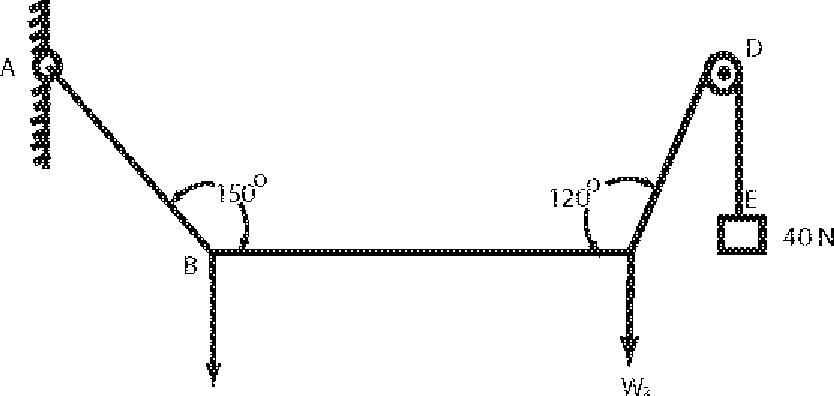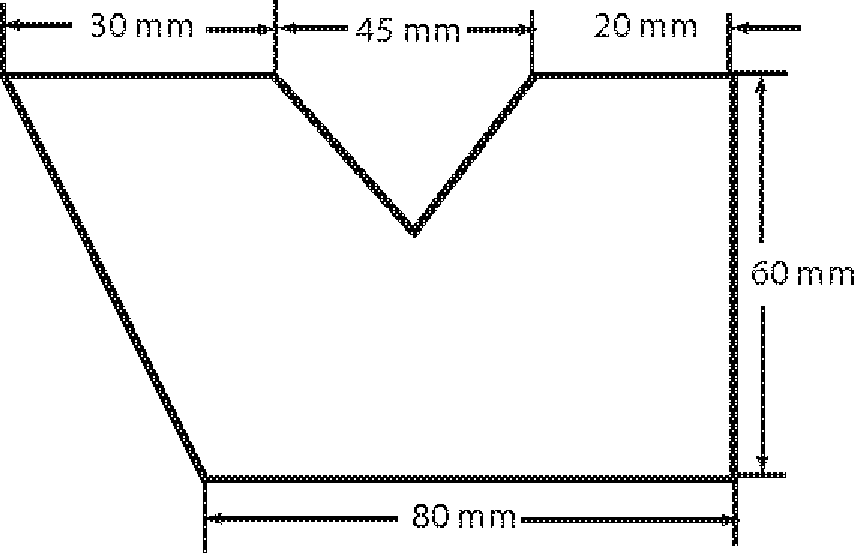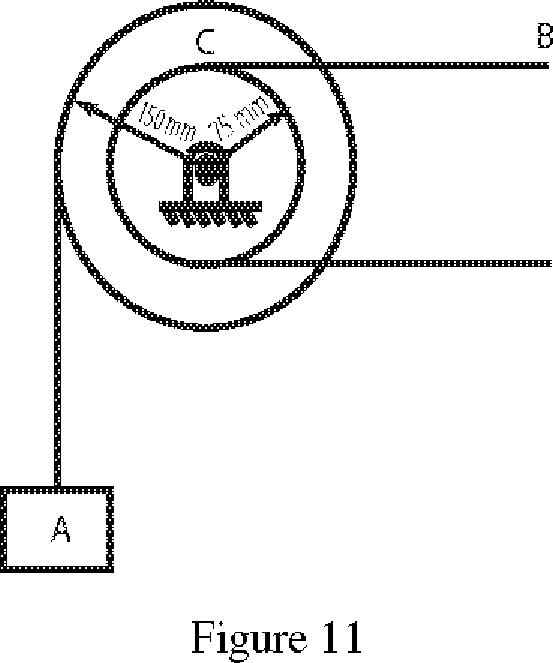Calicut University 2009-2nd Sem B.Tech 1st and of 2010 &2011 - Question Paper
COMBINED 1st AND 2nd SEMESTER B.TECH. (ENGINEERING)
DEGREE EXAMINATION, MAY 2011
EN 04 107 (A)-ENGINEERING MECHANICS (A)
ans all ques..
Part A
every ques. carries five marks.
I. (a) State and prove Lami's theorem.
(b) discuss the various kinds of forces with neat sketch.
(c) State the factors influencing friction.
(d) elaborate prinicipal axes and principle moments of inertia ?
(e) describe the term 'support reaction'. define the analytical as well as graphical methods for
finding out the support reactions of a beam carrying vertical loads only.
(D What is a plane truss? elaborate the assumptions made in the analysis of plane trusses?
(g) State and prove the working energy formula.
(h) State and prove the D'Alembert's Principle.
II. (a) An automobile is pulled by means of trucks as shown in Figure 1. If the resulting of the two
forces acting on the automobile is 25 kN being directed along the positive direction of
X-axis, determine the angle e of the cable attached to the track at B such that the force FB
in this cable is minimum. What is the magnitude of force in every cable when this occurs?
Fig.l.
Or
www.edutalks.org
(b) If the tension in wire 'AB' is 75 kN, determine the needed values of tensions in 'AC' and
'AD', so that the resulting of the 3 forces applied at 'A' is vertical as shown in Fig.2.
obtain also the resulting.
Fig.2.
III. (a) A block of weight WI = 1290 N rests on a horizontal surface and supports a different block of
weight W2 =570 N on top of it as shown in Figure 3. Block of weight W2 is attached to a
vertical wall by an inclined string AB. obtain the force 'P' applied to the lower block, that will
be necessary to reason the slipping to impend. Coefficient of friction ranging from blocks one and 2
= 0.25 and coefficient of friction ranging from block one and horizontal surface = 0040.
Fig.3.
Or
(b) obtain the mass moment of inertia of the body shown in FigA. with respect to X and Yaxis.
The body is made of aluminium with density 2800kg/m3.
www.edutalks.org
IV. (a) Draw shear force bending moment diagrams for the simply supported beam shown III
Figure.5.
~
ttOONlm~ ,
Ar=2,"-:C~ '::")n\ ~_~9
V. (a) A tower is 90 m. in height. A particle is dropped from the top of the tower and at the identical
time a different particle is projected upward from the foot of the tower both the particle meet
at a height of 30 m. obtain the velocity with which the 2nd particle is projected upward.
Or
(b) A body weighing 196.2 N slides up a 30° inclined plane under the action of an applied force
300 N acting parallel to the inclined plane. The coefficient of friction is 0.2. The body moves
from rest. Determine :
(i) Acceleration of the body;
(ii) Kinetic energy of the body after four seconds ;
(iii) Work done on the body in four seconds;
(iv) Impulse applied in four seconds
COMBINED FIRST AND SECOND SEMESTER B.TECH (ENGINEERING) DEGREE EXAMINATION, MAY 2010
PTEN/EN09 105 - ENGINEERING MECHANICS (Common to all branches)
(2009 admissions)
Time : Three hours Maximum:70 marks
Part A
Answer all questions
1. State parallelogram law of forces.
2. Define angle of repose.
3. State perpendicular axis theorem.
4. Define impulse-momentum principle.
5. State the equation of motion for translation.
(5x2 = 10 marks)
Part B
Answer any four questions
6. A ball Q of weight 12 N rests in a right angled trough as shown in Figure 1. Determine the forces exerted on the sides of the trough at D and B if all surfaces are perfectly smooth.
7. A block of weight 150 N is resting on a rough inclined plane as shown in Figure 2. The block is tied up by a horizontal string which has a tension of 50 N. Find (i) the frictional force on the block (ii) the normal reaction of the inclined plane (iii) the coefficient of friction between the surfaces of contact.
 |
|
Figure 2 |
8. Derive the mass moment of inertia of a sphere.
9. A block weighing 100 N, rests on a horizontal plane as shown in Figure 3. Find the magnitude of the force P, require to move the block at an acceleration of 2 m/sec2 towards right. Take the coefficient of friction between the block and the plane as 0.25.
10. A bullet of mass 30 g moving horizontally with a velocity of 450 m/sec strikes a wooden block of weight 45 N, resting on a rough horizontal floor. The bullet is embedded into the block and then both block and bullet move as a single unit. Calculate the distance moved. Take = 0.45.
11. The 15 kg uniform cylinder having 150 mm radius shown in Figure 4 is rolled up the 20 incline with an initial speed of 15 m/sec. Determine the maximum distance that the cylinder will roll up the incline. Assume that no slipping occurs.
(4 x 5 = 20 marks)
 |
|
Figure 4 |
PartC
Answer section (a) or (b).
Each carries 10 marks
12. (a) ABCD is weightless rod under the action of four forces P, Q, S and T as shown in Figure 5. If p = 10 N, Q = 4 N, S =
8 N and T = 12 N, calculate the resultant in magnitude and direction. Also locate its point of application with respect to the end A of the rod.
 |
|
Figure 5 |
Or
(b) A fine light string ABCDE whose extremity A is fixed, has weights Wi and W2 attached to it B and C. It passes round small smooth peg at D carrying a weight of 40 N at the few end E as shown in Figure 6. If in the position of equilibrium, BC is horizontal and AB and CD makes 150 and 120 with BC. With BC, find (i) tension in the portion AB, BC and CD of the string; and (ii) magnitudes of Wi and W2.
 |
|
Figure 6 |
13. (a) A cantilever truss supported on rollers at E and hinged at A is loaded as shown in Figure 7. Determine the reactions at A and E.
 |
|
Figure 7 |
Or
(b) find the moment of inertia about the centroidal axes for the section shown in Figure 8.
 |
|
Figure 8 |
14. (a) Two blocks A and B of weight 80 N and 60 N are connected by a string and passes over a frictionless pulley as shown in Figure 9. Determine the acceleration of blocks A and B and the tension in the string.
Figure 9
Or
(b) A projectile is fired from the edge of a 150 m height cliff with an initial velocity of 180 m/sec at angle of elevation of 30 with the horizontal. Neglecting a resistance, find
(i) the greatest elevation above the ground reached by the projectile; and (ii) the horizontal distance from the gun to the point where the projectile strikes the ground.
(a) Load A is connected to a double by one of the two in-extensible cables as shown in Figure 10. The motion of the pulley is controlled by the cable B, which has a constant acceleration of 1 m/sec2 and an initial velocity of 1.5 m/sec, both directed to the right. Determine (i) number of revolutions executed by the pulley in 5 seconds; (ii) the velocity and change in position in load A after 5 seconds.

Or
(b) A composite pulley of weight 500 N and radius of gyration of 0.4 m is attached with two blocks A and B of weights 1000 N and 2000 N respectively as shown in Figure 11. Determine the angular acceleration of the pulley and the tension in the strings by using D Alemberts principle.
(4 x 10 = 40 marks)
2000 N B
Figure 10
www.edutalks.org
C 15009 (Pages : 2) Name......
Reg. No.
COMBINED FIRST AND SECOND SEMESTER B.TECH. (ENGINEERING) DEGREE EXAMINATION, MAY 2011
EN 09 106BASICS OF CIVIL AND MECHANICAL ENGINEERING
(2009 admissions)
Time : Three Hours Maximum : 70 Marks
Section I (Basics of Civil Engineering) and Section II (Basics of Mechanical Engineering) are to be answered in separate answer-books.
Assume suitable data wherever necessary.
Section I (Basics of Civil Engineering)
Part A Answer all questions.
1. What are the functions of a Civil Engineer ?
(2 marks) (2 marks) distances and
2. Name the different types of beams.
3. Surveying is defined as the process of measuring-
distances,
-angles in order to determine the location of points on, above or below the earth surface.
(1 mark)
Part B
Answer any two questions.
4. Compare between English and Flemish bond. (5 marks)
5. Explain about the temperory adjustments of a levelling instrument. (5 marks)
6. What are the factors influencing the selection of a bridge ? (5 marks)
Part C
Answer section (a) or section (b) of each question.
7. (a) Compare between Brick masonry and Stone masonry.
Or
(b) Write in detail about the properties of concrete.
8. (a) Draw a neat sketch by showing the cross-sectional details of a gravity dam and explain its
features.
Or
(b) (i) Define super elevation. Explain the purpose of super elevation. (6 marks)
(ii) Find the superelevation to be provided to the carriageway of a road on a horizontal curve of radius 200 m. The average speed of vehicles may be taken as 45 km./hr.
(4 marks)
Turn over
Section II (Basics of Mechanical Engineering)
Part A Answer all questions.
1. Distinguish between Carburettor type and MPFI engines. (2 marks)
2. What is meant by priming of pumps ? Is it necessary to prime all the types of pumps ? (2 marks)
3. Give the classifications of IC engines. (1 mark)
Part B
Answer any two questions.
4. Draw the layout of Nuclear power plants. (5 marks)
5. Compare between two stroke and four stroke engines. (5 marks)
6. Show the relationship between Power transmitted by a belt system; belt tension and coefficient of friction.
(5 marks)
Part C
Answer section (a) or section (b) of each question.
7. (a) Explain the following with the help of necessary figures :
(i) CRDI engines.
(ii) Otto cycles.
(iii) Tidal power plants.
Or
(b) Explain in detail of the first law of thermodynamics with internal energy concept.
8. (a) Write a detailed note on centrifugal pumps.
Or
(b) Write short notes on :
. (i) Sand casting processes.
(ii) Hydrostatic extrusion.
(iii) 3 roll process.
(2 x 10 = 20 marks)
www.edutalks.org
COMBINED FIRST AND SECOND SEMESTER B.TECH (ENGINEERING) DEGREE EXAMINATION, MAY 2010
PTEN/EN09 106 - BASICS OF CIVIL AND MECHANICAL ENGINEERING (2009 admissions)
Time : Three hours Maximum:70 marks
Part A
Sections I and II are to be answered in separate answer books. Assume suitable data wherever necessary
Section I (Basics of civil engineering)
Part A
Answer all questions
1. Explain about Laterite stone.
(2 marks) (2 marks) (1 mark)
2. Define header and stretcher.
3. Define magnetic bearing.
PartB
Answer any two questions
4. Explain in detail about the test and characteristics of good bricks.
(5 marks)
5. What are the various types of cements? Write about the properties and uses of the cement.
(5 marks)
6. Write the types and functions of column. (5 marks)
Part C
Answer section (a) or section (b) of each question
7. (a) Define surveying. Briefly describe about the chain and
accessories.
Or
(b) Draw a neat sketch of a bowstring girder bridge. Explain in detail. (10 marks)
8. (a) Draw a neat sketch of English bond (1 brick wall and 1 brick wall thickness). Explain in brief.
Or
(b) What are the properties and applications cement mortar and cement concrete? (10 marks)
Section II (Basics of mechanical engineering)
Part A
Answer all questions
1. Draw an ideal PV diagram of a four stroke SI engine (Otto cycle).
(2 marks)
2. Write short notes of diesel power plants. (2 marks)
3. Name the main elements in a transmission system. (1 marks)
PartB
Answer any two questions
4. Derive the efficiency of the Brayton cycle. (5 marks)
5. Write short notes on carburetter and MPFI engines. (5 marks)
6. Write a short note on 2 roll process. (5 marks)
PartC
Answer section (a) or section (b) of each question.
7. (a) A pump develops a head of 10 m of water column. The discharge is 600 litres/min. Determine the motor power if the overall efficiency is 0.5 and the medium pumped is the water.
(b) Discuss in detail about the slider crank mechanism
10 marks
(a) i. Compare four stroke and two stroke engine. (5
marks)
ii. Compare between SI and Cl engine. (5 marks)
Or
(b) Explain in detail about the refrigeration and air conditioning with a neat sketch.
(5 marks)
www.edutalks.org
C 15006 (Pages : 2) Name.....................................
Reg. No..................................
COMBINED FIRST AND SECOND SEMESTER B.TECH. (ENGINEERING) DEGREE EXAMINATION, MAY 2011
EN 09 104/PTEN 09 104ENGINEERING CHEMISTRY
(2009 admissions)
Time : Three Hours Maximum : 70 Marks
Part A
Answer all questions.
Each question carries 2 marks.
1. Differentiate between n-type and p-type semiconductors.
2. A sample of water contains the following impurities :
Mg (HC03)2 = 75 mg/L, CaCl2 =278 mg/L and MgS04 = 142 mg/L.
Calculate the temporary and permanent hardness.
3. Name the monomers of Bakelite.
4. What is an hydrogen electrode ?
5. What is direct corrosion ?
(5 x 2 = 10 marks)
Part B
Answer any four questions.
Each question carries 5 marks.
6. Explain the classification and applications of liquid crystals.
7. How is water softened by lime soda process ?
8. Briefly discuss the applications of polymers in electrical and electronic industry.
9. Derive the expression for EMF in concentration cells.
10. How is pH measured using glass electrode ?
11. Discuss differential aeration corrosion with an example.
(4 x 5 = 20 marks)
Part C
Answer Section (a) or Section (b) of each question.
Each question carries 10 marks.
12. (a) (i) Write a short note on ultrapure silicon production.
(ii) Give the BIS specification for drinking water.
Or
(b) How is hardness of water determined experimentally by EDTA method ?
Turn over
13. (a) With a neat diagram, discuss the demineralization of water using ion exchange method.
Or
(b) Explain the cationic, anionic and free radical mechanisms of polymerization reactions.
14. (a) (i) Explain the theory of extreme pressure lubrication. (5 marks)
(ii) Derive the expression for single electrode potential. (5 marks)
Or
(b) Describe the construction and functioning of lead acid accumulators and Ni-Cd cells.
15. (a) Briefly discuss on galvanic series and galvanic corrosion.
Or
(b) (i) Explain the cause and consequence of photochemical smog. (5 marks)
PTEN/EN09 104 - ENGINEERING CHEMISTRY (2009 admissions)
Time : Three hours Maximum:70 marks
Part A
Answer all questions Each question carries 2 marks.
1. What are semiconductors? Give an example for n-type semiconductors.
2. What is the hardness of water? How is it expressed?
3. Give one example each for thermoplastic and thermosetting polymers.
4. Define reduction potential and oxidation potential.
5. Define Pilling-Bed Worth rule.
(5 x 2 = 10 marks)
PartB
Answer any four questions Each questions carry 5 marks.
6. Write about the applications of carbon nanotubes and nanowires.
7. How is hardness of water sample estimated through EDTA titration?
8. Discuss the mechanism of cationic polymerization.
9. What are synthetic rubbers? Give the preparation and structure of any two synthetic rubbers.
10. The potential of a hydrogen gas electrode in a solution of an acid of unknown strength is 0.29V at 298 K as measured against normal hydrogen electrode. Calculate the pH of acid solution.
11. Give an account on photochemical smog and ozone depletion.
(4 x 5 = 20 marks)
Answer section (a) or section (b) of each question.
Each question carries 10 marks.
12. (a) Discuss all aspects of electrical conductivity in solids based
on band theory.
(b) Bring out the various steps involved in the purification of water for domestic use.
13. (a) Explain the structure relation to properties of polymers.
Discuss the process and applications of vulcanization.
(b) Explain thin film mechanism of lubrication. Discuss any four properties of lubricants.
14. (a) What are fuel cells? Explain the construction and applica
tions of H2/O2 fuel cells.
(b) i. Derive Nemst equation.
ii. Write short notes on solar cells.
Explain the mechanism of wet corrosion. Give details of corrosion protection through sacrificial anodic method and impressed current method.
i. How are metals protected from corrosion by electroplating?
(b)
ii. Write a short account on thermal pollution.
(4 x 10 = 40 marks)
www. edut alks. org
|
Attachment: |
| Earning: Approval pending. |
